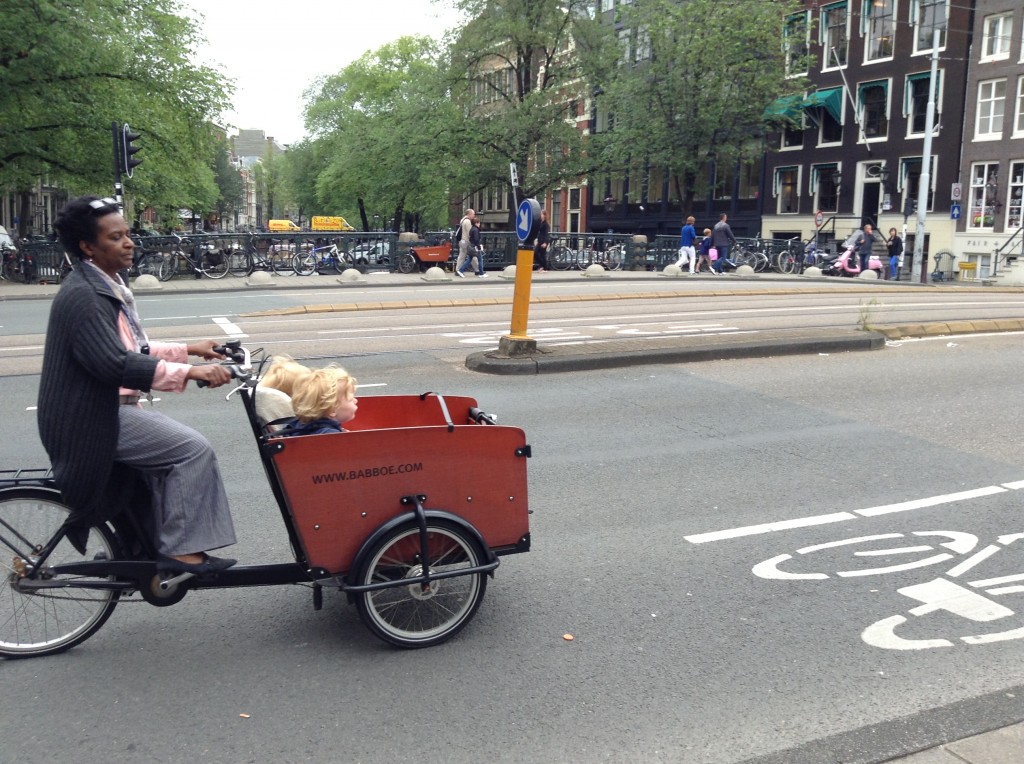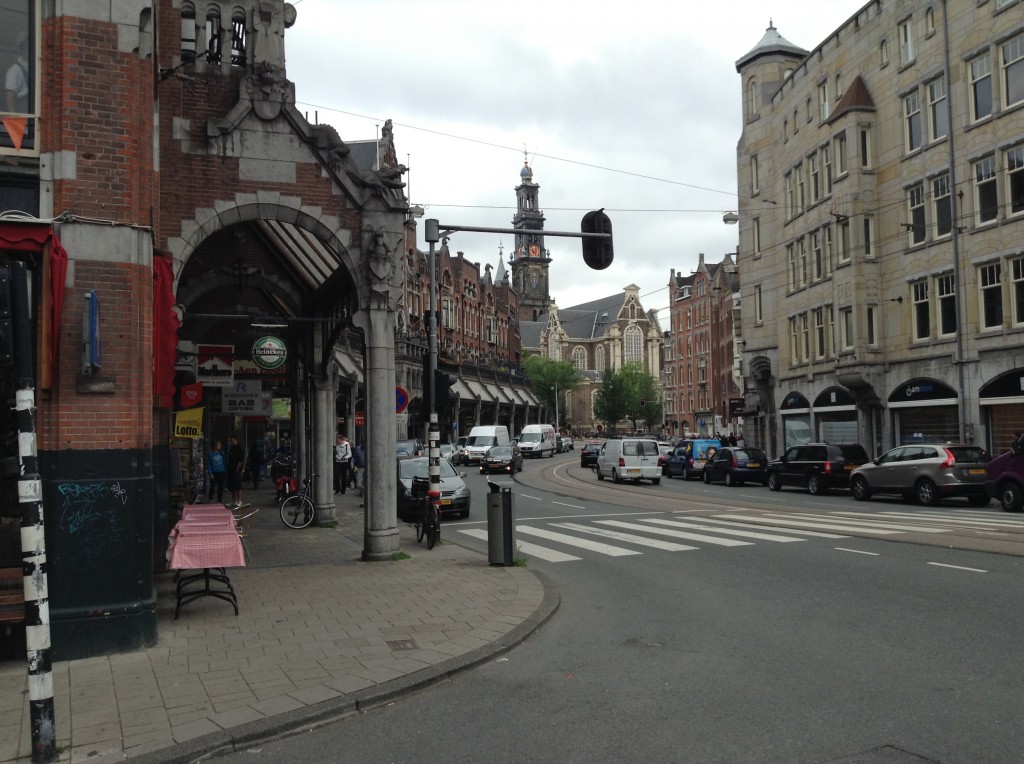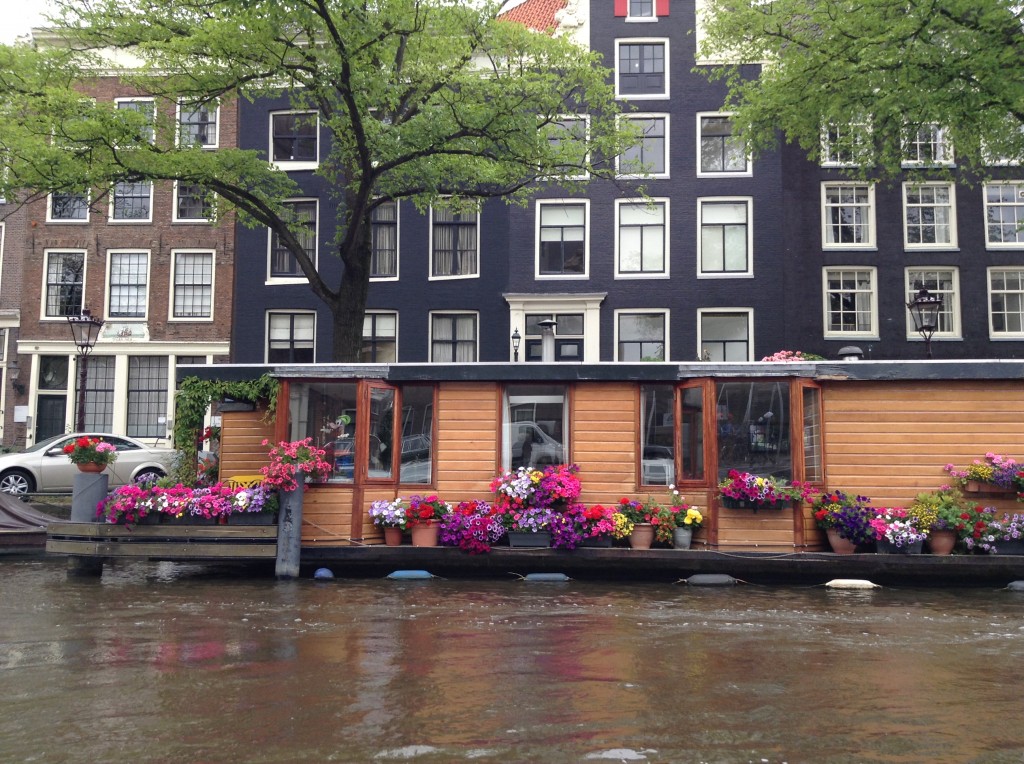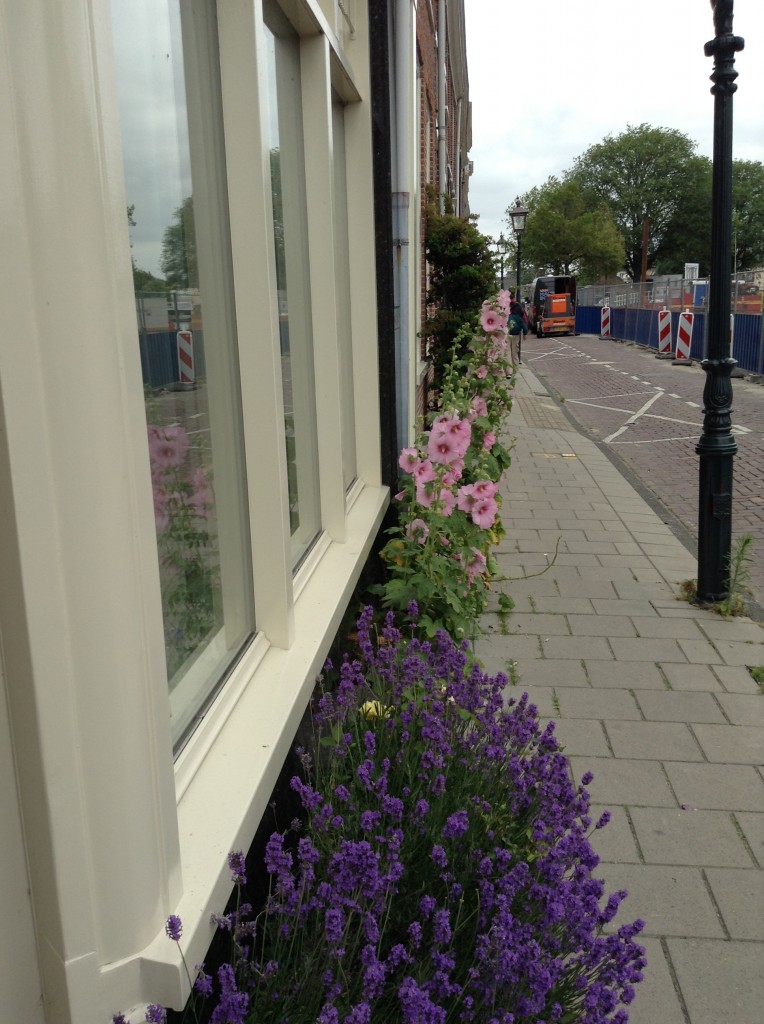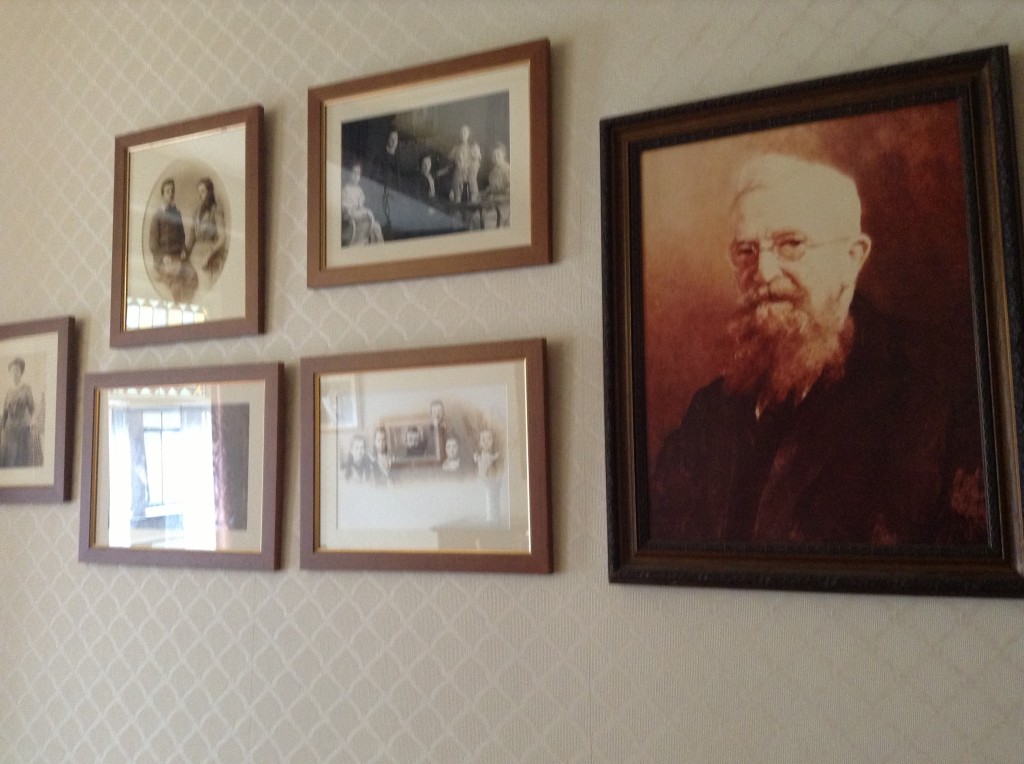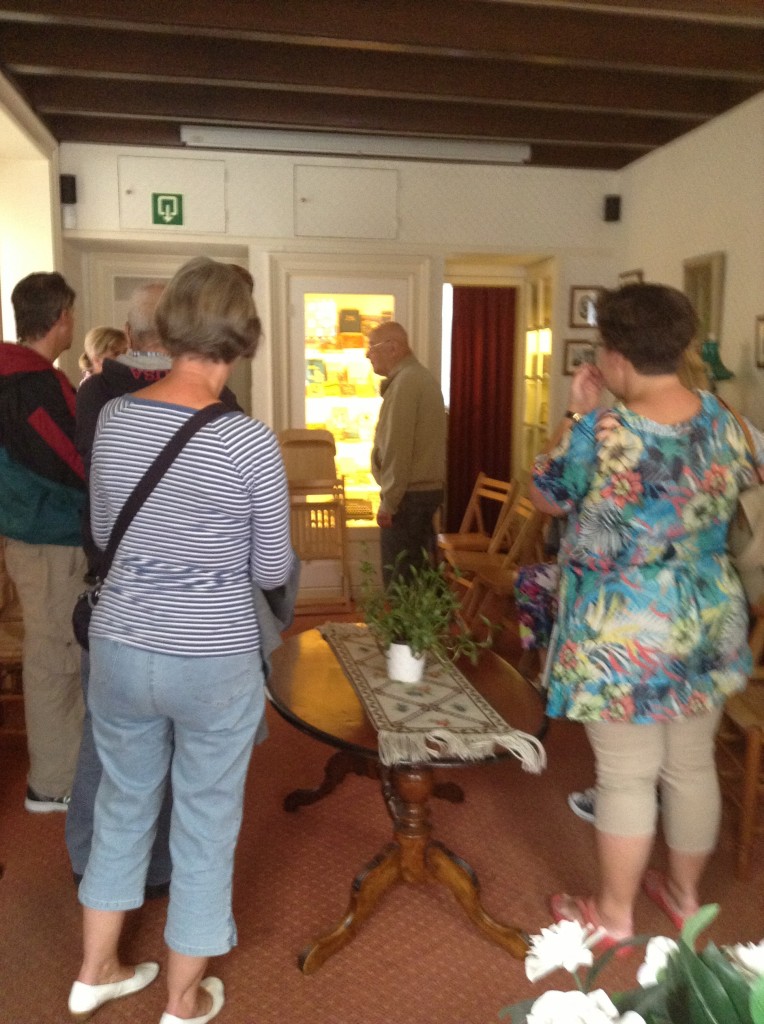I must uphold my ideals, for perhaps the time will come when I shall be able to carry them out.
– Anne Frank-
It is either an appalling thing or a good thing that I have walked more in the past 48 hours in Amsterdam than I did all of last year in America.
As we headed out to the Anne Frank home I tried to talk Tim into renting a bike. Yes. Just one. Hopefully with a seat like this for me. Needless to say, he declined.
When we arrived, the line to the Anne Frank home snaked around two city blocks. There are plenty of times when Tim and I don’t agree on things but when it comes to waiting in line, that’s when we are at our married best – we both agreed to come back later. One chap who was sitting with his grandson recommended we come back at 7;30 p.m. “Lines are much shorter then. Or you can buy tickets online and by-pass this.” Who knew?
We opted to take the canal tour instead, which just so happened to be right there, near Westerkerk, the largest Protestant church in all of the Netherlands. Construction on the church began in 1620 and lasted until 1631. I was shocked, I’ll tell you, to learn that mega-churches weren’t solely a capitalistic invention. But like everything but the Internet and Coke, Europeans at least did it better. They built beautiful mega-churches and not these stadium warehouses that we call church. About that Internet? I’ve learned that if I lay flat in the middle of the bed and hold the laptop in the center of Rembrandt’s collar, which is directly over the bed, I can sometimes get a connection. Should Rembrandt’s collar fall from the ceiling, I may lose an arm.
That’s the Middle-Ages version of a mega-church , there, with the tall steeple. It is also where Tim spent the entire last day of our time in Amsterdam because he is a directionally-challenged, absent-minded, deaf professor who does not listen or pay attention. But that’s another story for a day when I am not inclined to scream obscenities.
We took a canal ride, which is a must do, when you find yourself in Amsterdam. In fact, can I suggest getting off the main roads whenever you can. Rembrandt Square is a lovely spot to have a cup of coffee and much quieter (and cleaner) than Dam Square. Tourists to this town need a lesson in cleanliness. The side streets are lovely and pleasant places to walk. Nice neighborhoods. But Dam Square and the vicinity around it is nasty with trash by mid-afternoon because apparently people who wear clothes that make them look like gaudy throw pillows are too thoughtless to use the many, many trash cans provided by the city and merchants. How lazy does a person have to be to not throw their own trash away? C’mon y’all.
The Dutch love their flowers, and I love seeing the houseboats and window boxes filled with them.
Of course, they have their own version of a South Georgia trailer park, too.
After the canal ride, we rode the train out to Haarlem. One of the must-dos for me was visiting Corrie Ten Boom’s home. How many of you read The Hiding Place? Or Tramp for the Lord? I came across the lavender and hollyhocks while following Tim down another road where he didn’t have a clue where he was headed. My Granny Ruth used to grow hollyhocks. The side streets in Haarlem are full of them.
And when Tim’s leading the way you can be sure you are going to see a lot of side streets.
Just so you know, the Corrie Ten Boom home is not down this street. Go back to the center of the shopping district a couple of streets over and look for the Ten Boom watch and jewelry shop. The home is around the corner from that. If you happen to go inside the shop the shopowner will tell you where the home is, but the other six people I asked, all locals, had never heard of Corrie Ten Boom. Anyway, there’s a black door in the alleyway with a small sign on the door telling you to wait until someone comes to get you. Remember when you had to sit in the doctor’s office waiting on the results of a pregnancy test? It’s kind of the same.
By the time someone came to the door, I was so weary of waiting that I agreed to join the only tour going — all in Dutch. I had no idea what the lady was saying but I already knew the story, having read most of Ten Boom’s books. By the way, the Ten Boom jewelry store is no relation to the Ten Boom family. It’s just a matter of capitalizing on a name that the locals don’t recognize anymore. Brooks Brothers, and Kim Kardashian? Those names they know.
Because I don’t speak or understand Dutch — only 30 million do — I didn’t know I wasn’t supposed to take these photos of the Ten Boom family.
Or this one of all the Dutch-understanding people who had gathered in the living room above the watch shop.
But it is perfectly okay to take snapshots in Corrie’s bedroom which was The Hiding Place. The Jews and others that Corrie and her family hid had 70 seconds to get from whatever spot in the three-story home that the were in and through the bottom shelf of the closet door and into the hiding place, a tight-spot behind a brick wall. Seventy seconds for eight people. Can you imagine?
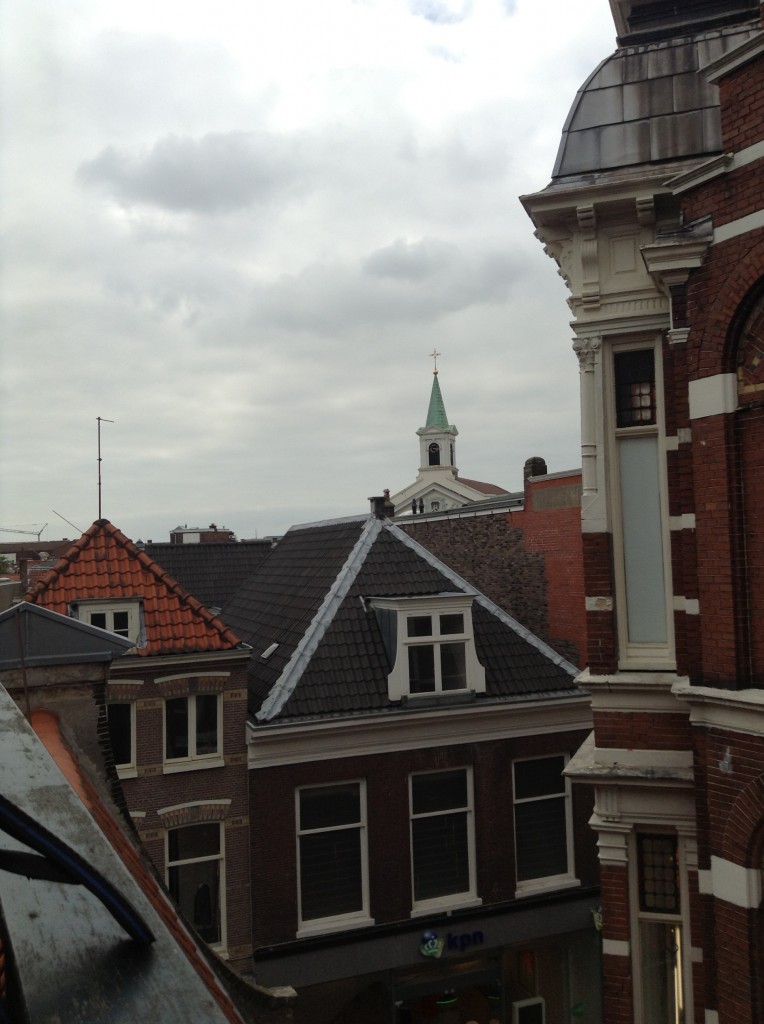
Sometimes, those in hiding could sneak out to the rooftop for a breath of fresh air. But they could only do so because the neighbors on either side of the Ten Boom family agreed to help protect those that the Nazi regime sought.
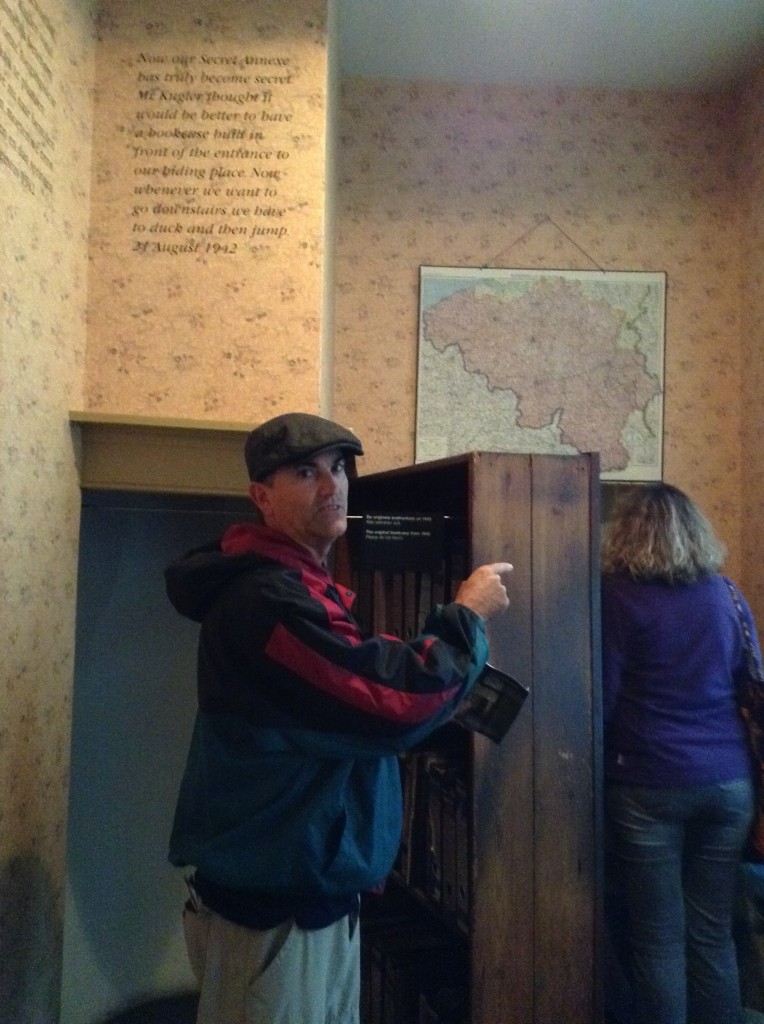
But, as with Anne Frank and her family, Corrie’s family, too, was taken into custody by the Nazi regime and sent off to be tortured to death in the concentration camps. “You think these things will never happen again,” said the Dutch woman giving the tour. “But I don’t know. Maybe so.”
She was a young girl during the war, and yet, the memories of the winter of 1944 have lingered with her all these years. Memories of having nothing to eat. Memories of when the soldiers dropped tin cans full of hard biscuits from the skies days before Liberation. “Boy, were those biscuits hard too. You could break your teeth on them. We had to soak them in water before we could eat them.”
A group of 20-somethings from Australia and California joined up with the English-speaking tour. “Why did you do this tour?” the tour guide asked.
“Because it was in the guide book,” came the reply.
“Perhaps the guidebook did not tell you of Corrie Ten Boom’s faith,” the woman said. “But I will.”
My friend Chad Gibbs said the hardest thing about going through the Anne Frank home was seeing the markings the mother made of how the children had grown. I winced when I saw it. Marking the growth of a child who very well may never see adulthood is such an act of faith and hope.
Anne Frank did not make it out alive, but her beloved Papa did.
Corrie Ten Boom made it out alive , but her beloved sister did not.
I heard Corrie Ten Boom speak at an Easter sunrise service at the Portland Convention Center my first spring in Oregon.
Corrie shared the story about going to the train station with her father as a young girl. In her eager excitement over taking a trip, Corrie would beg her father to let her hold the ticket but he would always tell her “No, Corrie, you may lose it.” (Like Tim did between the train station and the town square in Haarlem, you mean?) Corrie would get frustrated because she so wanted to hold the ticket. But her father insisted that she must wait until it was time to board the train, then she could have it.
That’s how God’s grace is, Corrie said. He gives it to us when we need it most, never before then.
Corrie said had she known what terrors were to come, she could never have survived even the thought of them. But when she needed it most, God gave her the grace to get through, moment-by-moment.
Standing at the train station in Haarlem, and later, reading Anne Frank’s handwritten diary, I was struck by a tsunami of hopefulness.
Not in mankind so much.
But in the God who made us.
I’ve said it before but never is it more clear to me than when I am standing on the ground consecrated by the suffering of others: God does not waste a hurt.
Ever.


